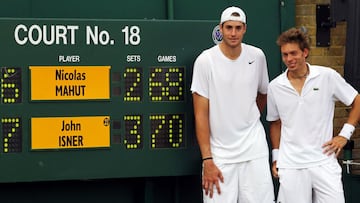TENNIS
What is a super tiebreak in tennis? Points, rules and how it is played
Whether it’s the Australian Open, Wimbledon or the grand slam events in France and the United States, a never-ending match isn’t going to work.

Most sports have a time limit. That means that fans know roughly how long the event will last and can plan around it. This is true in soccer, basketball, football and boxing, to name just a few, although each of those have there own flexibilities and occasional irregularities. Then there’s tennis.
Tennis matches could go on forever
The sport of tennis, which has origins that date back to the 12th century in the monastic cloisters of northern France, has evolved in a number of ways over the years. A tie is not an acceptable way to end an encounter and so we hold on until there’s a winner. But in this particular racket sport, it may take several hours to see a victor proclaimed.
In the early 1950′s James H. Van Alen, an American benefactor and founder of the International Tennis Hall of Fame at the Newport Casino - the largest tennis museum in the world - proposed the tiebreak to resolve the issue of lengthy matches.
What is a tiebreak?
When the set reaches 6-6 in games, rather than playing on continuously until someone wins by two games, a tiebreak settles things. That’s when you’ll see 7-6 plus a score in brackets. The tiebreak is a decided with the first to reach seven points, with each player alternating serve, explained below. The requirement to win by two points means it can go on a little while.
These tiebreaks happen in the early sets, but in the final, decisive set (third for women/doubles and fifth for men in the majors) then a super tiebreak is used.
What is a super tiebreak?
A super tiebreak is just like any other tiebreak in tennis, but it is played to 10 points instead of the aforementioned seven. Due to this, super tiebreaks are also known as 10-point tiebreaks.
This rule, which has only been introduced in the grand slam events (Australian, French and US Opens plus Wimbledon) in recent years and removes the chance of those seemingly endless affairs. Who remembers the 11 hours of Isner vs Mahut in 2010?
Serving rules during super tiebreaks
Technically, when a super tiebreaker is played during the final set, the previous order of service is maintained.
The first player or team to serve will serve the tiebreaker’s first point. The opposing player or team will then serve the next two points. After this, each player or team will take turns serving two points until the super tiebreaker ends.
Scoring and changing ends in a super tiebreak
When it comes to scoring, points given during a super tiebreaker have the same weight as in a regular tiebreak. The first player or team who can get 10 points with a two-point lead wins the entire match. If there is a 10-point tie during a super tiebreak, the match will continue up until a two-point lead has been achieved. So it too can go on but nothing like with the previous rule.
Another special rule during super tiebreaks is when players can change ends of the court. Players or teams change ends after the first point. Then it happens every six points. Another option for changing ends is to switch after the first point and then after every four points. This is more helpful for players especially when a tennis match is played outdoors and there are bad weather conditions.
To keep the action going, and likely the chances of a quicker resolution, rest breaks are not allowed during super tiebreaks. This is why players take the opportunity to drink water and recharge while changing ends.
How the tiebreak system was implemented in Majors
Tournaments like the US Open and Wimbledon handled tiebreaks differently than regular-season games. But since March 2022, the governing body of the sport’s most prestigious events (the Grand Slam Board) said all four tennis Grand Slams would use a super tiebreak (10-point tiebreak) in the final set on a trial basis, which started with the 2022 French Open.
Here’s how the major tournaments handled the ‘sudden deaths’ till Roland Garros 2022:
Australian Open: In the first Grand Slam tournament of the calendar, singles players used the super tiebreak when the game score in the final set of a singles match reached 6-6.
French Open: Until 2022, the Parisian competition was the only Major that didn’t use any ‘sudden death’ to determine a winner in the final set in singles games.
US Open: In New York, players used a 12-point tiebreaker in the event of a 6-6 tie in the final set.
Wimbledon: At the All England Club, competitors had to win the final set by two games. However, in 2019 Wimbledon introduced the tiebreak in the final set in case both players reached a 6-6 games scoreline.





